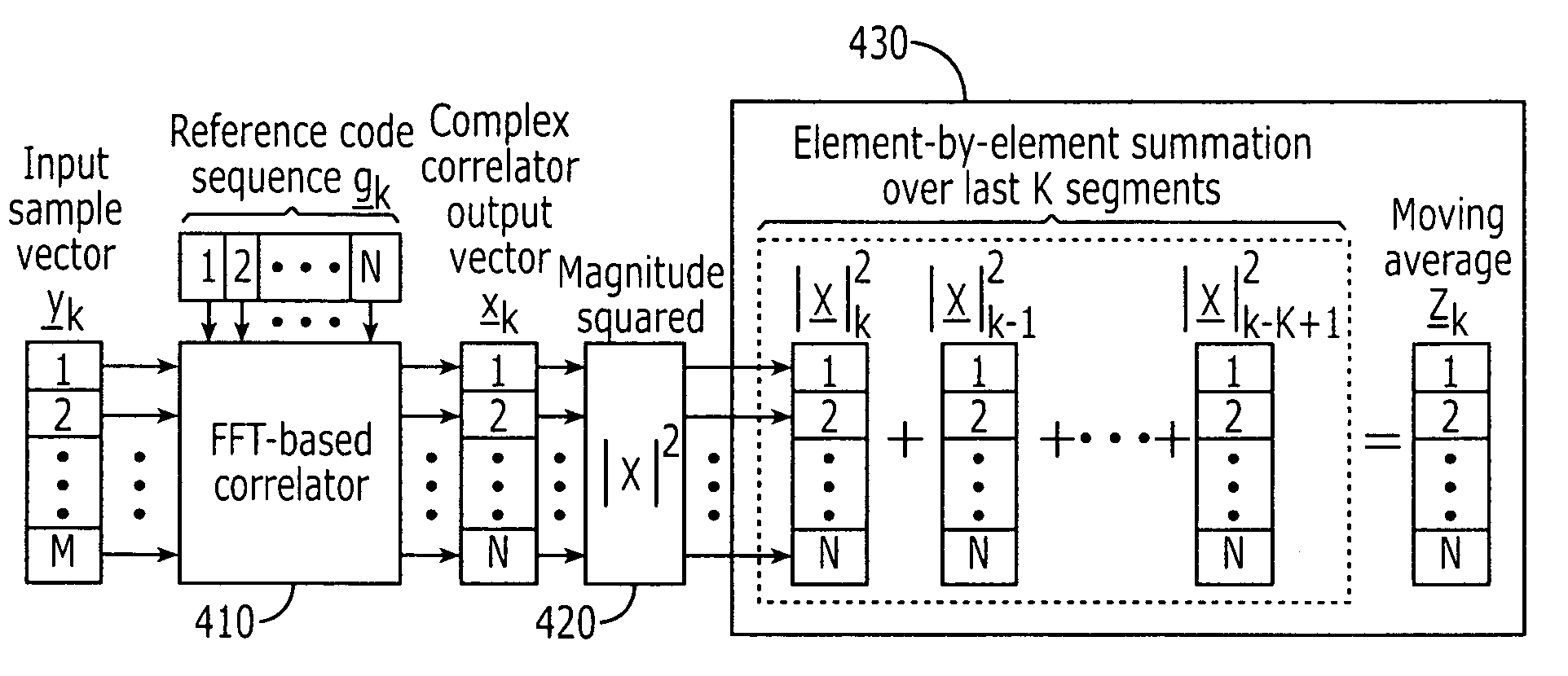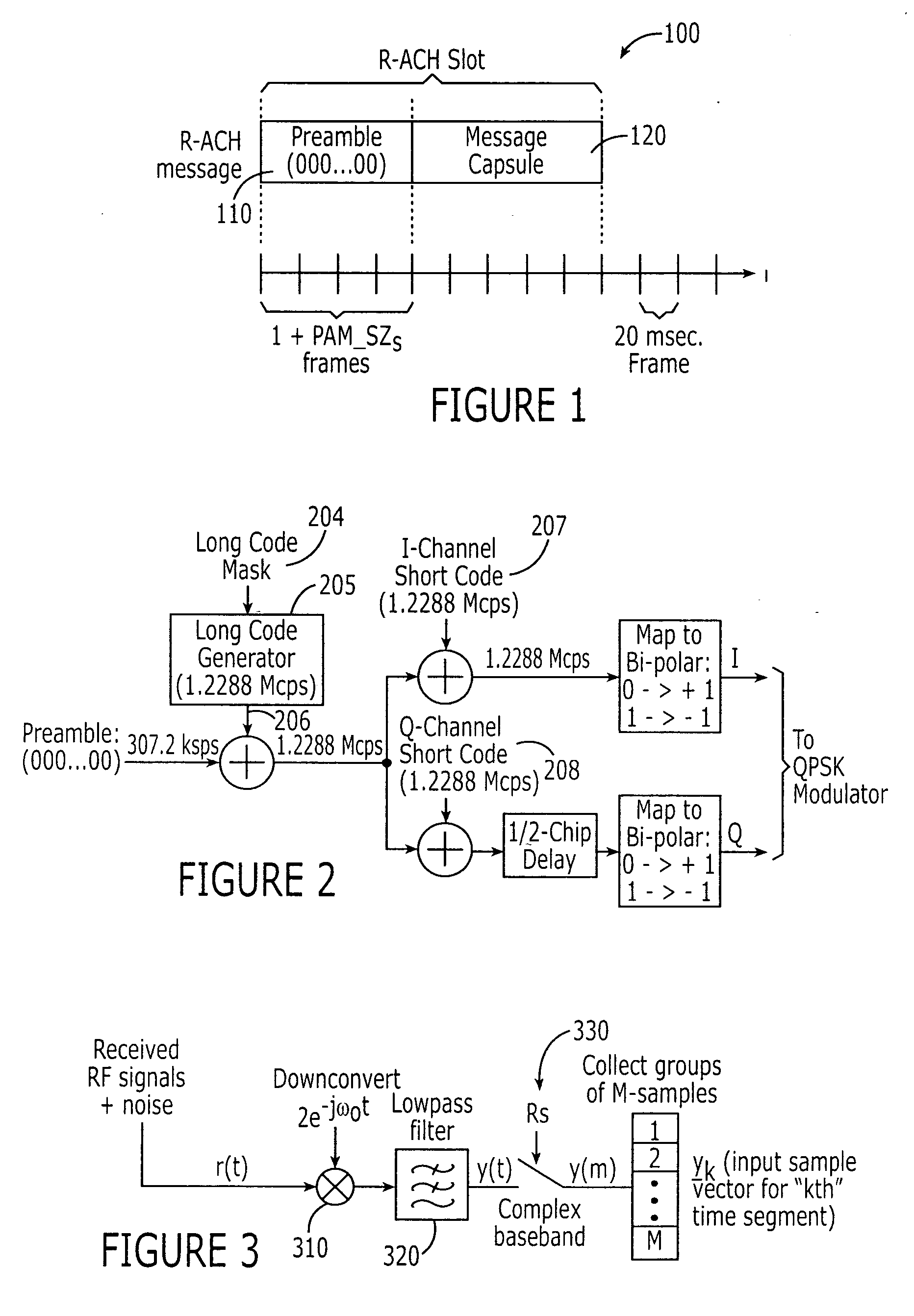Code synchronization in CDMA satellite wireless communications system using uplink channel detection
a wireless communications system and code synchronization technology, applied in the field of wireless communications systems and methods, can solve the problems of introducing a much longer path delay and a much greater delay variability in cdma operation using a satelli
- Summary
- Abstract
- Description
- Claims
- Application Information
AI Technical Summary
Problems solved by technology
Method used
Image
Examples
case 1
Index “n” Aligned with Received R-ACH Preamble PN-Offset
[0064] For this case, equation (13) provides an applicable expression for xk(n). Then:
|xj(n)|2=wj″Re2(n)+wj″Im2(n) (31)
For the derivation that follows, the random variables wj″Re(n) and wj″Im(n) are treated as being statistically independent. This may be the case between different time segments j, but may not be rigorously correct within the same time segment. This is because both wj″Re(n) and wj″Im(n) share the same component terms, but multiplied in different combinations as shown in equations (14) and (15). However, since there are a large number of product terms comprising wj″Re(n) and wj″Im(n), and these product terms are uniquely different between the two random variables, it is expected that wj″Re(n) and wj″Im(n) will appear uncorrelated, so that the independence assumption appears reasonable.
[0065] Substituting equation (31) into equation (29) yields: zk(n)=∑j=k-K+1k[wj″ Re2(n)+wj″ Im2(n)].(32)
Assuming stat...
case 2
Index in Not Aligned Wraith Received R-ACH PN-Offset
In this case, equation (24) provides an applicable expression for xk(n), and:
|xj(n)|2=wj′Re2(n)+wj′Im2(n). (38)
Substituting equation (38) into equation (29) yields: zk(n)=∑j=k-K+1k[wj Re′ 2(n)+wj Im′ 2(n)].(39)
As in Case 1, it may be assumed that random variables wj′Re(n) and wj′Im(n) are mutually independent, and independent across all time segments j. From equations (27) and (28), both wj′Re(n) and wj′Im(n) are zero-mean normal random variables with variance:
σ2=2M(I+1) (40)
Because the random variables wj′Re(n) and wj′Im(n) are zero-mean, the sum-of-squares in equation (39) produces a (central) chi-squared probability distribution with 2K degrees of freedom. Thus, the conditional probability density function of zk(n), given that the received R-ACH preamble is not aligned with offset index n, may be given by the following expression for a chi-squared distribution: fz 〈z|not aligned〉=ⅇ-(z / 2 σ2)(z / σ2)(K...
PUM
 Login to View More
Login to View More Abstract
Description
Claims
Application Information
 Login to View More
Login to View More - R&D
- Intellectual Property
- Life Sciences
- Materials
- Tech Scout
- Unparalleled Data Quality
- Higher Quality Content
- 60% Fewer Hallucinations
Browse by: Latest US Patents, China's latest patents, Technical Efficacy Thesaurus, Application Domain, Technology Topic, Popular Technical Reports.
© 2025 PatSnap. All rights reserved.Legal|Privacy policy|Modern Slavery Act Transparency Statement|Sitemap|About US| Contact US: help@patsnap.com



